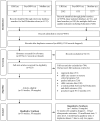Education of staff in preschool aged classrooms in child care centers and child outcomes: A meta-analysis and systematic review
- PMID: 28854281
- PMCID: PMC5576714
- DOI: 10.1371/journal.pone.0183673
Education of staff in preschool aged classrooms in child care centers and child outcomes: A meta-analysis and systematic review
Abstract
Staff education is considered key to quality of early childhood education and care (ECEC) programs. However, findings about associations between staff education and children's outcomes have been inconsistent. We conducted a systematic review and meta-analysis of associations between ECEC staff education and child outcomes. Searches of Medline, PsycINFO, and ERIC, websites of large datasets and reference sections of all retrieved articles were conducted. Eligible studies provided a statistical link between staff education and child outcomes for preschool-aged children in ECEC programs. Titles, abstracts and paper reviews as well as all data extraction were conducted by two independent raters. Of the 823 studies reviewed for eligibility, 39 met our inclusion criteria. Research in this area is observational in nature and subject to the inherent biases of that research design. Results from our systematic review were hampered by heterogeneity in how staff education was defined, variability in whose education was measured and the child outcomes that were assessed. However, overall the qualitative summary indicates that associations between staff education and childhood outcomes are non-existent to very borderline positive. In our meta-analysis of more homogeneous studies we identified certain positive, albeit very weak, associations between staff education and children's language outcomes (specifically, vocabulary and letter word identification) and no significant association with a mathematics outcome (WJ Applied Problems). Thus, our findings suggest that within the range of education levels found in the existing literature, education is not a key driver of child outcomes. However, since we only explored levels of education that were reported in the literature, our findings cannot be used to argue for lowering education standards in ECEC settings.
Conflict of interest statement
Figures







References
-
- Capizzano J, Main R. Many young children spend long hours in child care [Internet]. Washington, DC: U.S. Urban Institute; 2005. http://www.urban.org/sites/default/files/alfresco/publication-pdfs/31115...
-
- Sinha M. Childcare in Canada [Internet]. Ottawa, ON; 2014. http://www.statcan.gc.ca/pub/89-652-x/89-652-x2014005-eng.pdf.
-
- U.S. Department of Labor, Women’s Bureau. 20 Facts on Women Workers [Internet]. Washington DC; 2000. http://babel.hathitrust.org/cgi/pt?id=uiug.30112048171083
-
- NICHD ECCRN. Early child care and children’s development prior to school entry: results from the NICHD study of early child care. Am Educ Res J. 2002;39: 133–164. doi: 10.3102/00028312039001133 - DOI
-
- Laurin J, Geoffroy M, Boivin M, Japel C, Raynault M, Tremblay R, et al. Child care services, socioeconomic inequalities, and academic performance. Pediatrics. 2015;136 doi: 10.1542/peds.2015-0419 - DOI - PubMed
Publication types
MeSH terms
LinkOut - more resources
Full Text Sources
Other Literature Sources
Medical
Miscellaneous

